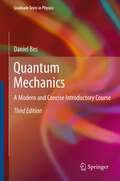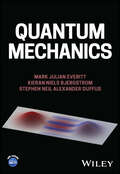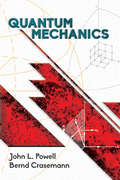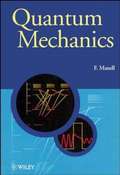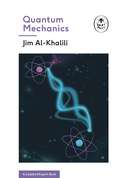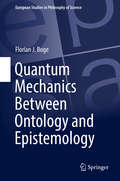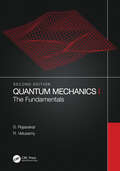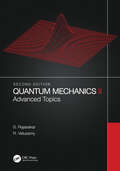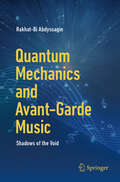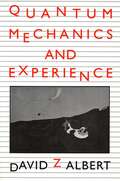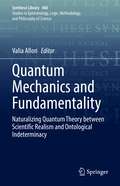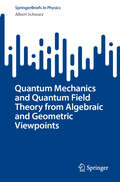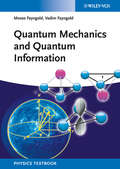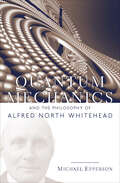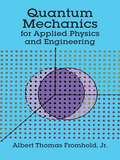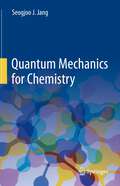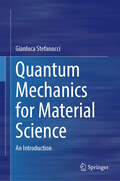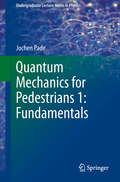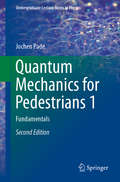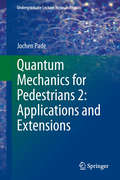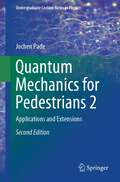- Table View
- List View
Quantum Mechanics
by Daniel BesStarting from basic principles, the book covers a wide variety of topics, ranging from Heisenberg, Schroedinger, second quantization, density matrix and path integral formulations of quantum mechanics, to applications that are (or will be) corner stones of present and future technologies. The emphasis is on spin waves, quantum information, recent tests of quantum physics and decoherence. The book provides a large amount of information without unbalancing the flow of the main ideas by laborious detail.
Quantum Mechanics
by Eugene D. ComminsEugene D. Commins takes an experimentalist's approach to quantum mechanics, preferring to use concrete physical explanations over formal, abstract descriptions to address the needs and interests of a diverse group of students. Keeping physics at the foreground and explaining difficult concepts in straightforward language, Commins examines the many modern developments in quantum physics, including Bell's inequalities, locality, photon polarization correlations, the stability of matter, Casimir forces, geometric phases, Aharonov-Bohm and Aharonov-Casher effects, magnetic monopoles, neutrino oscillations, neutron interferometry, the Higgs mechanism, and the electroweak standard model. The text is self-contained, covering the necessary background on atomic and molecular structure in addition to the traditional topics. Developed from the author's well-regarded course notes for his popular first-year graduate course at UC Berkeley, instruction is supported by over 160 challenging problems to illustrate concepts and provide students with ample opportunity to test their knowledge and understanding.
Quantum Mechanics
by Gennaro Auletta Mauro Fortunato Giorgio ParisiThe important changes quantum mechanics has undergone in recent years are reflected in this new approach for students. A strong narrative, and over 300 worked problems lead the student from experiment, through general principles of the theory, to modern applications. Stepping through results allows students to gain a thorough understanding. Starting with basic quantum mechanics, the book moves on to more advanced theory, followed by applications, perturbation methods and special fields, and ending with new developments in the field. Historical, mathematical, and philosophical boxes guide the student through the theory. Unique to this textbook are chapters on measurement and quantum optics, both at the forefront of current research. Advanced undergraduate and graduate students will benefit from this new perspective on the fundamental physical paradigm and its applications. Online resources including solutions to selected problems, and 200 figures, with color versions of some figures, are available online.
Quantum Mechanics
by Mark Julian Everitt Kieran Niels Bjergstrom Stephen Neil DuffusQUANTUM MECHANICS From classical analytical mechanics to quantum mechanics, simulation, foundations & engineering Quantum mechanics is a fundamental and conceptually challenging area of physics. It is usually assumed that students are unfamiliar with Lagrangian and Hamiltonian formulations of classical mechanics and the role played by probability. As a result, quantum physics is typically introduced using heuristic arguments, obscuring synergies with classical mechanics. This book takes an alternative approach by leveraging classical analytical mechanics to facilitate a natural transition to quantum physics. By doing so, a solid foundation for understanding quantum phenomena is provided. Key features of this textbook include: Mathematics and Classical Analytical Mechanics: The necessary mathematical background and classical analytical mechanics are introduced gradually, allowing readers to focus on one conceptual challenge at a time. Deductive Approach: Quantum mechanics is presented on the firm foundation of classical analytical mechanics, ensuring a logical progression of concepts. Pedagogical Features: This book includes helpful notes, worked examples, problems, computational challenges, and problem-solving approaches to enhance understanding. Comprehensive Coverage: Including advanced topics such as open quantum systems, phase-space methods, and computational methods for quantum physics including good programming practice and code design. Much of the code needed to reproduce figures throughout this book is included. Consideration of Foundations: The measurement problem and correspondence principle are addressed, including an open and critical discussion of their interpretation and consequences. Introduction to Quantum Systems Engineering: This is the first book to introduce Quantum Systems Engineering approaches for applied quantum technologies development. This textbook is suitable for undergraduate students in physics and graduate students in mathematics, chemistry, engineering, and materials science.
Quantum Mechanics (Dover Books on Physics)
by Bernd Crasemann John L. PowellSuitable for advanced undergraduates, this thorough text focuses on the role of symmetry operations and the essentially algebraic structure of quantum-mechanical theory. Based on courses in quantum mechanics taught by the authors, the treatment provides numerous problems that require applications of theory and serve to supplement the textual material.Starting with a historical introduction to the origins of quantum theory, the book advances to discussions of the foundations of wave mechanics, wave packets and the uncertainty principle, and an examination of the Schrödinger equation that includes a selection of one-dimensional problems. Subsequent topics include operators and eigenfunctions, scattering theory, matrix mechanics, angular momentum and spin, and perturbation theory. The text concludes with a brief treatment of identical particles and a helpful Appendix.
Quantum Mechanics (Manchester Physics Series)
by Franz MandlThe Manchester Physics Series General Editors: D. J. Sandiford; F. Mandl; A. C. Phillips Department of Physics and Astronomy, University of Manchester Properties of Matter B. H. Flowers and E. Mendoza Optics Second Edition F. G. Smith and J. H. Thomson Statistical Physics Second Edition F. Mandl Electromagnetism Second Edition I. S. Grant and W. R. Phillips Statistics R. J. Barlow Solid State Physics Second Edition J. R. Hook and H. E. Hall Quantum Mechanics F. Mandl Particle Physics Second Edition B. R. Martin and G. Shaw The Physics of Stars Second Edition A. C. Phillips Computing for Scientists R. J. Barlow and A. R. Barnett Quantum Mechanics aims to teach those parts of the subject which every physicist should know. The object is to display the inherent structure of quantum mechanics, concentrating on general principles and on methods of wide applicability without taking them to their full generality. This book will equip students to follow quantum-mechanical arguments in books and scientific papers, and to cope with simple cases. To bring the subject to life, the theory is applied to the all-important field of atomic physics. No prior knowledge of quantum mechanics is assumed. However, it would help most readers to have met some elementary wave mechanics before. Primarily written for students, it should also be of interest to experimental research workers who require a good grasp of quantum mechanics without the full formalism needed by the professional theorist. Quantum Mechanics features: A flow diagram allowing topics to be studied in different orders or omitted altogether. Optional "starred" and highlighted sections containing more advanced and specialized material for the more ambitious reader. Sets of problems at the end of each chapter to help student understanding. Hints and solutions to the problems are given at the end of the book.
Quantum Mechanics (The Ladybird Expert Series #2)
by Jim Al-KhaliliWhat is quantum mechanics? Learn from the experts in the ALL-NEW LADYBIRD EXPERT SERIESA clear, simple and entertaining introduction to the weird, mind-bending world of the very, very small.Written by physicist and broadcaster Professor Jim Al-Khalili, Quantum Mechanics explores all the key players, breakthroughs, controversies and unanswered questions of the quantum world.You'll discover:- How the sun shines- Why light is both a wave and a particle- The certainty of the Uncertainty Principle- Schrodinger's Cat- Einstein's spooky action- How to build a quantum computer- Why quantum mechanics drives even its experts completely crazy'Jim Al-Khalili has done an admirable job of condensing the ideas of quantum physics from Max Planck to the possibilities of quantum computers into brisk, straightforward English' THE TIMESLearn about other topics in the Ladybird Experts series including The Big Bang, Gravity, Climate Change and Evolution.Written by the leading lights and most outstanding communicators in their fields, the Ladybird Expert books provide clear, accessible and authoritative introductions to subjects drawn from science, history and culture. For an adult readership, the Ladybird Expert series is produced in the same iconic small format pioneered by the original Ladybirds. Each beautifully illustrated book features the first new illustrations produced in the original Ladybird style for nearly forty years.
Quantum Mechanics Between Ontology and Epistemology (European Studies in Philosophy of Science #10)
by Florian J. BogeThis book explores the prospects of rivaling ontological and epistemic interpretations of quantum mechanics (QM). It concludes with a suggestion for how to interpret QM from an epistemological point of view and with a Kantian touch. It thus refines, extends, and combines existing approaches in a similar direction. The author first looks at current, hotly debated ontological interpretations. These include hidden variables-approaches, Bohmian mechanics, collapse interpretations, and the many worlds interpretation. He demonstrates why none of these ontological interpretations can claim to be the clear winner amongst its rivals. Next, coverage explores the possibility of interpreting QM in terms of knowledge but without the assumption of hidden variables. It examines QBism as well as Healey’s pragmatist view. The author finds both interpretations or programs appealing, but still wanting in certain respects. As a result, he then goes on to advance a genuine proposal as to how to interpret QM from the perspective of an internal realism in the sense of Putnam and Kant. The book also includes two philosophical interludes. One details the notions of probability and realism. The other highlights the connections between the notions of locality, causality, and reality in the context of violations of Bell-type inequalities.
Quantum Mechanics I: The Fundamentals
by S. Rajasekar R. VelusamyQuantum Mechanics I: The Fundamentals provides a graduate-level account of the behavior of matter and energy at the molecular, atomic, nuclear, and sub-nuclear levels. It covers basic concepts, mathematical formalism, and applications to physically important systems. This fully updated new edition addresses many topics not typically found in books at this level, including: Bound state solutions of quantum pendulum Morse oscillator Solutions of classical counterpart of quantum mechanical systems A criterion for bound state Scattering from a locally periodic potential and reflection-less potential Modified Heisenberg relation Wave packet revival and its dynamics An asymptotic method for slowly varying potentials Klein paradox, Einstein-Podolsky-Rosen (EPR) paradox, and Bell’s theorem Delayed-choice experiments Fractional quantum mechanics Numerical methods for quantum systems A collection of problems at the end of each chapter develops students’ understanding of both basic concepts and the application of theory to various physically important systems. This book, along with the authors’ follow-up Quantum Mechanics II: Advanced Topics, provides students with a broad, up-to-date introduction to quantum mechanics. Print Versions of this book also include access to the ebook version.
Quantum Mechanics II: Advanced Topics
by S. Rajasekar R. VelusamyQuantum Mechanics II: Advanced Topics offers a comprehensive exploration of the state-of-the-art in various advanced topics of current research interest. A follow-up to the authors’ introductory book Quantum Mechanics I: The Fundamentals, this book expounds basic principles, theoretical treatment, case studies, worked-out examples and applications of advanced topics including quantum technologies. A thoroughly revised and updated this unique volume presents an in-depth and up-to-date progress on the growing topics including latest achievements on quantum technology. In the second edition six new chapters are included and the other ten chapters are extensively revised. Features Covers classical and quantum field theories, path integral formalism and supersymmetric quantum mechanics. Highlights coherent and squeezed states, Berry’s phase, Aharonov—Bohm effect and Wigner function. Explores salient features of quantum entanglement and quantum cryptography. Presents basic concepts of quantum computers and the features of no-cloning theorem and quantum cloning machines. Describes the theory and techniques of quantum tomography, quantum simulation and quantum error correction. Introduces other novel topics including quantum versions of theory of gravity, cosmology, Zeno effect, teleportation, games, chaos and steering. Outlines the quantum technologies of ghost imaging, detection of weak amplitudes and displacements, lithography, metrology, teleportation of optical images, sensors, batteries and internet. Contains several worked-out problems and exercises in each chapter. Quantum Mechanics II: Advanced Topics addresses various currently emerging exciting topics of quantum mechanics. It emphasizes the fundamentals behind the latest cutting-edge developments to help explain the motivation for deeper exploration. The book is a valuable resource for graduate students in physics and engineering wishing to pursue research in quantum mechanics.
Quantum Mechanics and Avant-Garde Music: Shadows of the Void
by Rakhat-Bi Abdyssagin"Fascinating details and anecdotes accompany this engaging account of the emergence of dramatic new ideas and forms in music over the centuries..." David Politzer, winner of the 2004 Nobel Prize in Physics. "A thought-provoking, stimulating, and highly original exploration of deep metaphorical links between music and physics...Highly recommended." Prof. Ian Stewart FRS, author, What’s the Use? "An astonishing book!" Tristan Murail, composer and co-creator of the "spectral" technique. Have you ever wondered about the connection between Pauli's exclusion principle and Schoenberg's dodecaphony? Or the symphonic echoes of Heisenberg's uncertainty principle in the compositions of Stockhausen and Cage? This book not only poses these questions but skillfully uncovers the artistic answers, exploring interdisciplinary connections that bridge the gap between modern physics and contemporary music. Dive into philosophical discourses on time, witness the metamorphosis of Boolean algebra, bits, and qubits into musical notation, and discover the limitations of the 12-tone scale mirrored in the speed of light. The author's unique methodology offers a fresh perspective, linking the language of mathematics and physics to the creation of musical scores. This book transcends the boundaries of physics and music, revealing the inevitable fusion of modern physics and avant-garde music in the twentieth century. Through meticulous research, the author showcases the profound impact of revolutionary ideas such as quantum physics and relativity on all aspects of life and demonstrates that modern physics and contemporary music were born not out of chance—their emergence and development were inevitable events. Delving into the historical accounts, he explores the musical endeavors of great physicists like Max Planck and Albert Einstein, unraveling the quantum entanglement of physics mirrored in the extended techniques of contemporary music and unveiling the musical universe of Werner Heisenberg through captivating personal encounters with his descendants. Crafted for general readers and seasoned experts alike, the book maintains clarity and style, ensuring accessibility without sacrificing depth. This pioneering exploration not only draws connections between modern physics and music but also serves as a unique bridge for scientists, musicians, and the curious general audience. Requiring no formal background in physics or music, the book is a compelling read for those intrigued by the uncharted territories where science and art converge, offering a concise and illuminating journey into the shadows of the void.
Quantum Mechanics and Experience
by David Z. AlbertThe more science tells us about the world, the stranger it looks. Ever since physics first penetrated the atom, early in this century, what it found there has stood as a radical and unanswered challenge to many of our most cherished conceptions of nature. It has literally been called into question since then whether or not there are always objective matters of fact about the whereabouts of subatomic particles, or about the locations of tables and chairs, or even about the very contents of our thoughts. A new kind of uncertainty has become a principle of science. This book is an original and provocative investigation of that challenge, as well as a novel attempt at writing about science in a style that is simultaneously elementary and deep. It is a lucid and self-contained introduction to the foundations of quantum mechanics, accessible to anyone with a high school mathematics education, and at the same time a rigorous discussion of the most important recent advances in our understanding of that subject, some of which are due to the author himself.
Quantum Mechanics and Fundamentality: Naturalizing Quantum Theory between Scientific Realism and Ontological Indeterminacy (Synthese Library #460)
by Valia AlloriThis edited collection provides new perspectives on some metaphysical questions arising in quantum mechanics. These questions have been long-standing and are of continued interest to researchers and graduate students working in physics, philosophy of physics, and metaphysics. It features contributions from a diverse set of researchers, ranging from senior scholars to junior academics, working in varied fields, from physics to philosophy of physics and metaphysics. The contributors reflect on issues about fundamentality (is quantum theory fundamental? If so, what is its fundamental ontology?), ontological dependence (how do ordinary objects exist even if they are not fundamental?), realism (what kind of realism is compatible with quantum theory?), indeterminacy (can the world itself exhibit ontological indeterminacy?). The book contains contributions from both physicists (including Nobel Prize winner Gerard 't Hooft), science communicators and philosophers.
Quantum Mechanics and Quantum Field Theory
by Jonathan DimockExplaining the concepts of quantum mechanics and quantum field theory in a precise mathematical language, this textbook is an ideal introduction for graduate students in mathematics, helping to prepare them for further studies in quantum physics. The textbook covers topics that are central to quantum physics: non-relativistic quantum mechanics, quantum statistical mechanics, relativistic quantum mechanics and quantum field theory. There is also background material on analysis, classical mechanics, relativity and probability. Each topic is explored through a statement of basic principles followed by simple examples. Around 100 problems throughout the textbook help readers develop their understanding.
Quantum Mechanics and Quantum Field Theory from Algebraic and Geometric Viewpoints (SpringerBriefs in Physics)
by Albert SchwarzThis book offers a non-standard introduction to quantum mechanics and quantum field theory, approaching these topics from algebraic and geometric perspectives. Beginning with fundamental notions of quantum theory and the derivation of quantum probabilities from decoherence, it proceeds to prove the expression for the scattering matrix in terms of Green functions (LSZ formula), along with a similar expression for the inclusive scattering matrix. The exposition relies on recent findings by the author that provide a deeper understanding of the structure of quantum theory and extend beyond its traditional boundaries. The book is suitable for graduate students and young researchers in mathematics and theoretical physics seeking to delve into innovative concepts within quantum theory. The book contains many recent results therefore it should be interesting also to accomplished physicists and mathematicians.
Quantum Mechanics and Quantum Information
by Vadim Fayngold Moses FayngoldA thorough definition of the basic concepts of quantum mechanics and quantum information and their interrelations. Alongside a thorough definition of the basic concepts and their interrelations, backed by numerous examples, this textbook features a rare discussion of the quantum information theory. It also deals with other important topics hardly found in the literature, including the Robertson-Schrodinger-relation, angle and angular momentum uncertainties, interaction-free measurements, and the limitations of the no-cloning theorem.With its interpretations of quantum mechanics and its discussions of quantum computing, this book is poised to become the standard textbook for advanced undergraduate and beginning graduate quantum mechanics courses and as an essential reference for physics students and physics professionals.
Quantum Mechanics and the Philosophy of Alfred North Whitehead: And the Philosophy of Alfred North Whitehead (American Philosophy)
by Michael EppersonIn Process and Reality and other works, Alfred North Whitehead struggled to come to terms with the impact the new science of quantum mechanics would have on metaphysics.This ambitious book is the first extended analysis of the intricate relationships between relativity theory, quantum mechanics, and Whitehead's cosmology. Michael Epperson illuminates the intersection of science and philosophy in Whitehead's work-and details Whitehead's attempts to fashion an ontology coherent with quantum anomalies.Including a nonspecialist introduction to quantum mechanics, Epperson adds an essential new dimension to our understanding of Whitehead-and of the constantly enriching encounter between science and philosophy in our century.
Quantum Mechanics for Applied Physics and Engineering
by Albert T. Fromhold Jr.For upper-level undergraduates and graduate students: an introduction to the fundamentals of quantum mechanics, emphasizing aspects essential to an understanding of solid-state theory. A heavy background in mathematics and physics is not required beyond basic courses in calculus, differential equations, and calculus-based elementary physics. Numerous problems (and selected answers), projects, exercises.
Quantum Mechanics for Chemistry
by Seogjoo J. JangThis textbook forms the basis for an advanced undergraduate or graduate level quantum chemistry course, and can also serve as a reference for researchers in physical chemistry and chemical physics. In addition to the standard core topics such as principles of quantum mechanics, vibrational and rotational states, hydrogen-like molecules, perturbation theory, variational principles, and molecular orbital theories, this book also covers essential theories of electronic structure calculation, the primary methods for calculating quantum dynamics, and major spectroscopic techniques for quantum measurement. Plus, topics that are overlooked in conventional textbooks such as path integral formulation, open system quantum dynamics methods, and Green’s function approaches are addressed. This book helps readers grasp the essential quantum mechanical principles and results that serve as the foundation of modern chemistry and become knowledgeable in major methods of computational chemistry and spectroscopic experiments being conducted by present-day researchers. Dirac notation is used throughout, and right balance between comprehensiveness, rigor, and readability is achieved, ensuring that the book remains accessible while providing all the relevant details. Complete with exercises, this book is ideal for a course on quantum chemistry or as a self-study resource.
Quantum Mechanics for Material Science: An Introduction
by Gianluca StefanucciThis book is based on the course "Elements of Theoretical Physics," which the author has been teaching at the University of Rome Tor Vergata since 2017. It serves as an introduction to quantum mechanics, providing students with essential concepts and tools for future lessons, while still maintaining a comprehensive approach without relying heavily on the level of abstraction and mathematical rigor typically found in Physics programs. Understanding this book only requires knowledge of the mathematical concepts taught in the first two years of basic courses. The bachelor's degree program in Materials Science aims to train students with an interdisciplinary background in physics, chemistry, and engineering. While the study of quantum mechanics is essential, the same level of depth, abstraction, and mathematical rigor as in a Physics degree program is not a requirement. Unfortunately, most textbooks on Quantum Mechanics are geared toward Physics students, making it difficult to find suitable resources for Materials Science students. To make learning easier, the author has chosen not to refer students to various textbooks for different topics. Instead, he has created handouts that have evolved into a condensed textbook on quantum mechanics specifically tailored to the needs of the Materials Science program.
Quantum Mechanics for Pedestrians 1: Fundamentals
by Jochen PadeThis book provides an introduction into the fundamentals of non-relativistic quantum mechanics. In Part 1, the essential principles are developed. Applications and extensions of the formalism can be found in Part 2. The book includes not only material that is presented in traditional textbooks on quantum mechanics, but also discusses in detail current issues such as interaction-free quantum measurements, neutrino oscillations, various topics in the field of quantum information as well as fundamental problems and epistemological questions, such as the measurement problem, entanglement, Bell's inequality, decoherence, and the realism debate. A chapter on current interpretations of quantum mechanics concludes the book. To develop quickly and clearly the main principles of quantum mechanics and its mathematical formulation, there is a systematic change between wave mechanics and algebraic representation in the first chapters. The required mathematical tools are introduced step by step. Moreover, the appendix collects compactly the most important mathematical tools that supplementary literature can be largely dispensed. In addition, the appendix contains advanced topics, such as Quantum- Zeno effect, time-delay experiments, Lenz vector and the Shor algorithm. About 250 exercises, most of them with solutions, help to deepen the understanding of the topics. Target groups of the book are student teachers and all students of physics, as minor or major, looking for a reasonably easy and modern introduction into quantum mechanics.
Quantum Mechanics for Pedestrians 1: Fundamentals (Undergraduate Lecture Notes in Physics)
by Jochen PadeThis book, the first in a two-volume set, provides an introduction to the fundamentals of (mainly) non-relativistic quantum mechanics. This first volume chiefly focuses on the essential principles, while applications and extensions of the formalism can be found in volume 2. Including but also moving beyond material that is covered in traditional textbooks on quantum mechanics, the book discusses in detail current issues such as interaction-free quantum measurements or neutrino oscillations, as well as fundamental problems and epistemological questions, such as the measurement problem. A chapter on the postulates of quantum mechanics rounds off this first volume. In order to quickly and clearly present the main principles of quantum mechanics and its mathematical formulation, there is a systematic transition between wave mechanics and algebraic representation in the first few chapters, in which the required mathematical tools are introduced step by step. Moreover, the appendix concisely reviews the most important mathematical tools, allowing readers to largely dispense with supplementary literature. The appendix also explores advanced topics, such as the Quantum-Zeno effect and time-delay experiments. Over 250 exercises, most of them with solutions, help to deepen the reader’s understanding of the topics discussed. This revised second edition is expanded by an introduction to some ideas and problems of relativistic quantum mechanics. In this first volume, the Klein-Gordon and the Dirac equations are treated. Fundamentals of other areas are compiled in compact form, i.e., outlines of special relativity, classical field theory and electrodynamics. The book is chiefly intended for student science teachers and all students of physics, majors and minors alike, who are looking for a reasonably easy and modern introduction to quantum mechanics.
Quantum Mechanics for Pedestrians 2: Applications and Extensions
by Jochen PadeThe two-volume textbook Quantum Mechanics for Pedestrians provides an introduction to the basics of nonrelativistic quantum mechanics. Originally written as a course for students of science education, the book addresses all those science students and others who are looking for a reasonably simple, fresh and modern introduction to the field. The basic principles of quantum mechanics are presented in the first volume. This second volume discusses applications and extensions to more complex problems. In addition to topics traditionally dealt with in quantum mechanics texts, such as symmetries or many-body problems, here also issues of current interest such as entanglement, Bell's inequalities, decoherence and various aspects of quantum information are treated in detail. Furthermore, questions of the basis of quantum mechanics and epistemological issues are discussed explicitly; these are relevant e. g. to the realism debate. A chapter on the interpretations of quantum mechanics completes this volume. The necessary mathematical tools are introduced step by step; in the appendix, the most relevant mathematics is compiled in compact form. More advanced topics such as the Lenz vector, Hardy's experiment and Shor's algorithm are treated in more detail in the appendix. As an essential aid to learning and teaching, 130 exercises are included, most of them with their solutions.
Quantum Mechanics for Pedestrians 2: Applications and Extensions (Undergraduate Lecture Notes in Physics)
by Jochen PadeThis book, the second in a two-volume set, provides an introduction to the basics of (mainly) non-relativistic quantum mechanics. While the first volume addresses the basic principles, this second volume discusses applications and extensions to more complex problems. In addition to topics dealt with in traditional quantum mechanics texts, such as symmetries or many-body problems, it also treats issues of current interest such as entanglement, Bell’s inequality, decoherence and various aspects of quantum information in detail. Furthermore, questions concerning the basis of quantum mechanics and epistemological issues which are relevant e.g. to the realism debate are discussed explicitly. A chapter on the interpretations of quantum mechanics rounds out the book. Readers are introduced to the requisite mathematical tools step by step. In the appendix, the most relevant mathematics is compiled in compact form, and more advanced topics such as the Lenz vector, Hardy’s experiment and Shor’s algorithm are treated in more detail. As an essential aid to learning and teaching, 130 exercises are included, most of them with solutions. This revised second edition is expanded by an introduction into some ideas and problems of relativistic quantum mechanics. In this second volume, an overview of quantum field theory is given and basic conceptions of quantum electrodynamics are treated in some detail. Originally written as a course for students of science education, the book addresses all those science students and others who are looking for a reasonably simple, fresh and modern introduction to the field.
Quantum Mechanics for Scientists and Engineers
by David A. B. MillerIf you need a book that relates the core principles of quantum mechanics to modern applications in engineering, physics, and nanotechnology, this is it. Students will appreciate the book's applied emphasis, which illustrates theoretical concepts with examples of nanostructured materials, optics, and semiconductor devices. The many worked examples and more than 160 homework problems help students to problem solve and to practise applications of theory. Without assuming a prior knowledge of high-level physics or classical mechanics, the text introduces Schrdinger's equation, operators, and approximation methods. Systems, including the hydrogen atom and crystalline materials, are analyzed in detail. More advanced subjects, such as density matrices, quantum optics, and quantum information, are also covered. Practical applications and algorithms for the computational analysis of simple structures make this an ideal introduction to quantum mechanics for students of engineering, physics, nanotechnology, and other disciplines. Additional resources available from www. cambridge. org/9780521897839.
